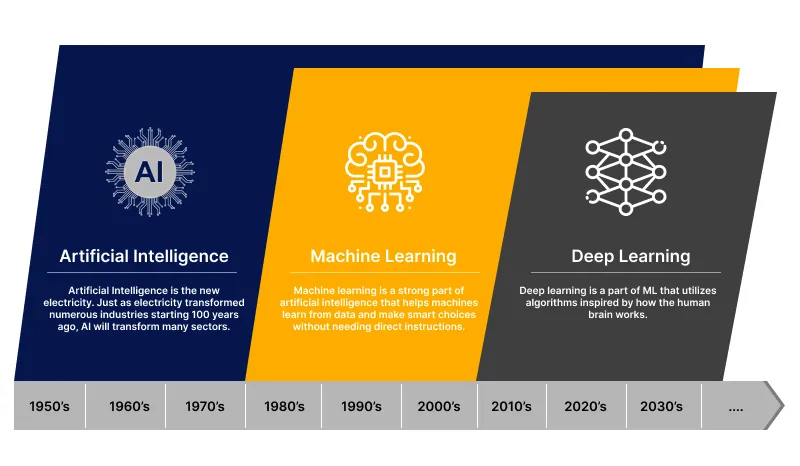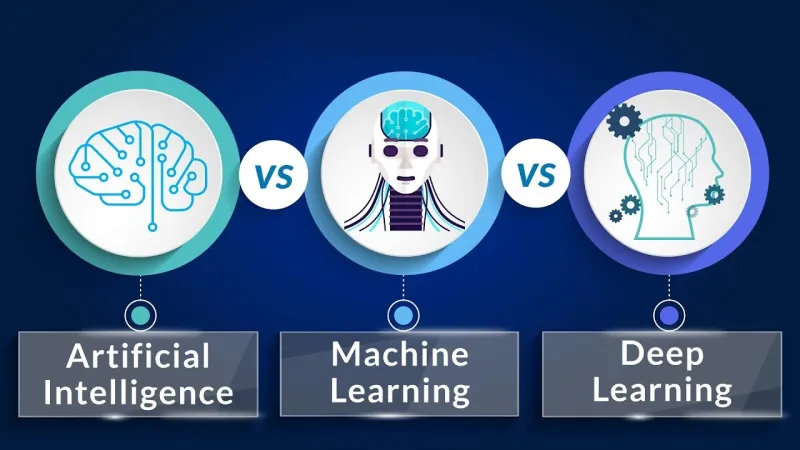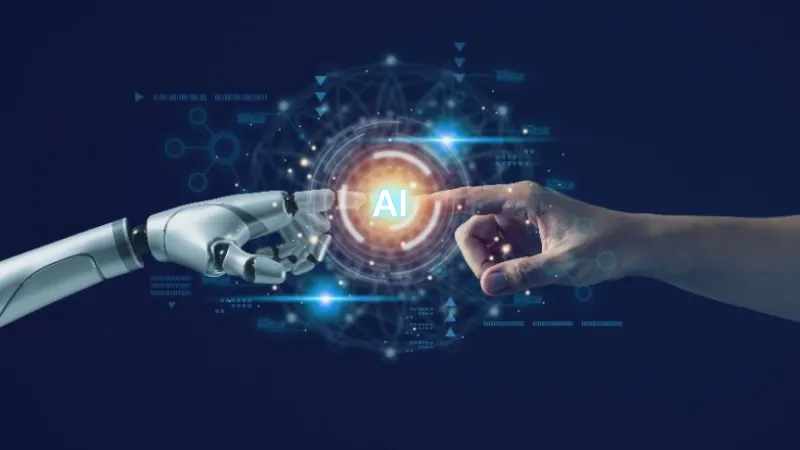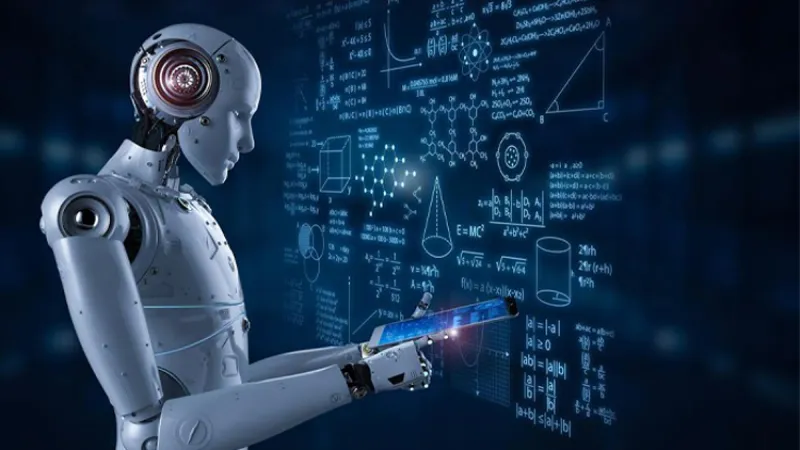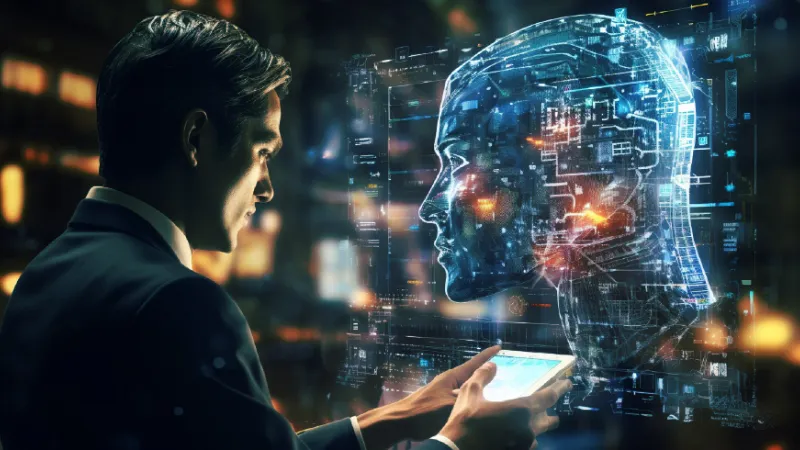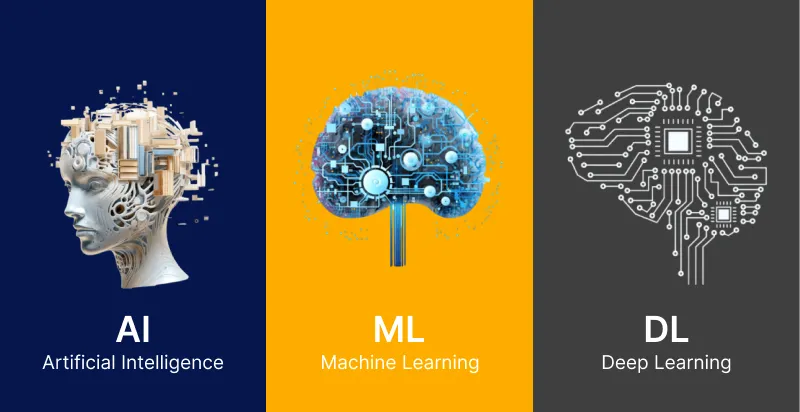AI, ML, and DL are the most talked-about technologies in today’s business world. Companies are using these innovations to develop smart machines and applications. Even though these terms are widely used in business discussions around the world, many people struggle to understand the differences between them. This blog aims to explain what AI, ML, and DL are and how they are different from each other.
Before we get into the technical details, let’s look at what tech influencers, industry experts, and authors have to say about these three concepts.
“Artificial Intelligence is the new electricity. Just as electricity transformed numerous industries starting 100 years ago, AI will transform many sectors.”
– Andrew Ng
“Deep Learning is like a rocket engine, and Big Data is the fuel.”
– Geoffrey Hinton
“Some people call this artificial intelligence, but the reality is this technology will enhance us. So instead of artificial intelligence, I think we’ll augment our intelligence.”
– Ginni Rometty
“The future of Artificial Intelligence is not about man versus machine, but rather about how we work together.”
– Fei-Fei Li
These three terms are often used interchangeably, but they don’t mean exactly the same thing.
Here is a visual aid to help us understand the basic differences between artificial intelligence, machine learning, and deep learning.
Artificial Intelligence involves creating smart machines. Machine Learning is a part of AI that helps build AI-driven applications. Deep Learning is a part of ML using large data and complex algorithms to train a model.
Now, let’s take a closer look at each of these technologies and compare AI vs ML vs DL to have a deeper understanding.
AI vs ML vs DL: Stats
Here are some statistics related to Artificial Intelligence, Machine Learning and Deep Learning:
- The global machine learning market was at $15.44 billion in 2021 and is expected to grow to $209.91 billion by 2029, with a compound annual growth rate (CAGR) of 38.8%.
- The AI market is expected to reach $500 billion in 2023 and $1,597.1 billion by 2030, with a compound annual groowth rate of 38.1% from 2022 to 2030.
- The global natural language processing market is forecasted to increase from $26.42 billion in 2022 to $161.81 billion by 2029.
Trust ValueCoders to keep your brand at the forefront of technological advancements and industry trends.
- 35% of companies reported that they are using AI in their business, while an additional 42% were exploring AI solutions.
- By 2025, nearly 100% of enterprises are expected to implement some form of AI.
- 46% of organizations are planning to utilize AI in the next three years.
These numbers show that machine learning and artificial intelligence are getting more popular in different industries. It seems like businesses are leaning towards using AI and ML to work better and come up with new ideas.
Also Read: 10 Ways Logistics Companies Can Benefit From AI/ML
Artificial Intelligence: Advanced Human Intelligence
Artificial Intelligence (AI) is the peak of human innovation, aiming to make machines capable of thinking, reasoning, and learning like humans. It’s about giving computers intelligence similar to human thinking so they can handle tough tasks and solve problems on their own.
Basic Concept
At its core, AI is about creating algorithms and systems that imitate human intelligence. These systems can analyze data, find patterns, make decisions, and adjust to new situations, similar to how humans operate. The aim is to make machines capable of doing tasks that usually need human intelligence, like understanding language, identifying objects in pictures, or playing strategic games.
How Does AI Work?
AI works using advanced algorithms that handle big sets of data and find important information. Machine learning, which is part of AI, helps computers learn from data and get better at tasks over time. Deep learning, another part of AI, uses artificial neural networks to understand complicated patterns in data, letting machines make highly accurate predictions and decisions.
Also Read: How AI is Changing Software Testing Forever?
Benefits of AI
AI has many benefits and helps in different areas. In business, it can do repetitive tasks automatically, make operations more efficient, and come up with new ideas based on data. In healthcare, AI can help diagnose illnesses, find new drugs, and plan personalized treatments. AI also makes user experiences better by giving virtual helpers, suggesting things personalized to each person, and predicting what might happen.
Types of AI
AI can be divided into different types based on its capabilities:
- Artificial Narrow Intelligence (ANI): ANI means AI systems made for certain tasks or areas, like playing chess, understanding speech, or driving a car.
- Artificial General Intelligence (AGI): AGI is like the ultimate goal of AI—it’s a system with intelligence similar to humans, able to understand, learn, and think in many different areas.
- Artificial Super Intelligence (ASI): ASI would be like AI on steroids—it would be even smarter than humans in every way and might have abilities we can’t even understand.
Find out how ValueCoders can integrate AI into your systems to boost productivity and customer satisfaction.
Applications of AI
AI finds applications in various fields, like healthcare, finance, transportation, and entertainment. Some common applications include:
- Chatbots for customer service
- Image and speech recognition
- Personalized recommendations on streaming platforms
- Autonomous vehicles for transportation
Artificial Intelligence has the potential to change how we live, work, and use technology. With the help of an AI development company, AI can find new ways to be innovative, work more effectively, and help society move forward.
Also read: Smart Finance’s Horizon: Navigating AI And ML In Banking & Insurance
Machine Learning: Let Machine Think Smartly
Machine learning is a strong part of artificial intelligence that helps machines learn from data and make smart choices without needing direct instructions. It’s like teaching a computer to think on its own by showing it examples and letting it learn from practice using machine learning models.
Basic Concept
Machine learning is about making algorithms and models that help computers find patterns and connections in data. These algorithms learn from big sets of data, where the computer keeps changing its settings to get better at a certain job. The aim is to make models that can work well with new data and make correct predictions or choices.
How Does ML Work?
Machine learning works by using special algorithms to look at data, find patterns, and make guesses or choices. These algorithms learn from both data and past experiences, changing how they work to get better as they go. To do this, the model gets trained on data that’s been labeled or not, then tested to see how well it does, and adjusted until it does what it’s supposed to do.
Also Read: Artificial Intelligence in HR: Use Cases, Challenges & Solutions
Benefits of ML
Machine learning development has many benefits. Using these algorithms, businesses can automate repetitive tasks, make processes better, and find useful information in data. Machine learning is used in lots of different ways, like guessing what will happen next, understanding language, recognizing pictures, and suggesting things to people. Basically, machine learning helps machines be smart and change when things around them change, which helps make industries more innovative and efficient.
Types of ML
- Supervised Learning: In supervised learning, the ML algorithm learns from data that’s been labeled, meaning the right answer is known. The algorithm learns how to match input data to these labeled outputs so it can guess what the answer might be for new data.
- Unsupervised Learning: In unsupervised learning, the algorithm learns from data that hasn’t been labeled, so there’s no right answer given. Instead, the algorithm figures out patterns or organization in the data on its own. Sorting data into groups and making it simpler are typical jobs for unsupervised learning.
- Reinforcement Learning: Reinforcement learning is a tactic where a machine learns by doing things in an environment to reach a goal. It gets feedback on what it does, like rewards or punishments, so it learns what works best through trying different things.
Learn how ValueCoders can empower your business with ML-driven insights and automation.
Applications of ML
Machine learning finds applications across various domains and industries, including:
- Predictive Analytics: Making guesses about what might happen in the future by looking at past data trends, behaviors, or outcomes.
- Natural Language Processing (NLP): Studying and making sense of human language so computers can do things like figure out how someone feels, translate languages, and chat with people.
- Image Recognition: Figuring out what’s in pictures or videos, like finding objects, people, or patterns. This is used in things like recognizing faces and finding objects.
- Recommendation Systems: Suggesting things like products, services, or content to users depending on what they like and what they do.
In simple terms, machine learning helps machines be smart and adjust to new situations, which makes industries more innovative and efficient.
Also Read: The Convergence Of AI/ML And Wearables: What’s In Store For The Healthcare Industry
Deep Learning: New Face of Advanced Technology
Deep learning is a part of ML that utilizes algorithms inspired by how the human brain works. These algorithms can handle lots of different types of data, whether it’s organized neatly or messy. The main idea behind deep learning is to use artificial neural networks, which help machines make choices.
Basic Concept
Deep learning is all about using artificial neural networks, which are like the brain’s structure, to understand data better. These networks have many layers of connected nodes called neurons. As data moves through these layers, it gets analyzed and understood in more and more complicated ways.
How Does DL Work?
Deep learning algorithms analyze big sets of data using layers of neural networks. Each layer finds more important parts of the data, letting the system understand it better. By going through this process many times, the system learns to see data in more complex ways. To get better, the algorithm changes how the nodes are connected to make fewer mistakes, using a method called backpropagation.
Benefits of DL
Deep learning offers several key advantages:
- Improved Results: Deep learning algorithms can reach extremely high levels of accuracy and effectiveness in jobs like recognizing images, understanding language, and creating speech.
- Self-Learning: Deep learning systems can learn and change by themselves when they get new data, cutting down on the need for people to step in and program them every time.
- Flexibility: Deep learning models can be used in many different areas and industries, like healthcare, finance, self-driving cars, and robots.
Types of DL
- Convolutional Neural Networks (CNNs): CNNs are really good at jobs like recognizing images, finding objects, and understanding what’s in pictures. They do this by breaking down visual information into different layers of filters that specialize in different things.
- Recurrent Neural Networks (RNNs): RNNs are great for jobs that involve looking at data in order, like recognizing speech, translating languages, and studying how things change over time. They’re good at this because they can understand how one thing leads to another over time.
- Generative Adversarial Networks (GANs): GANs are used to create new examples of data, like images, music, or text. They work by training two neural networks together in a competition. One network makes new data, while the other checks if it looks real or not.
Discover how ValueCoders can transform your business processes with DL techniques for image recognition, NLP, and more.
Applications of DL
Deep learning finds applications across a wide range of industries and domains:
- Healthcare: Figuring out illnesses from medical pictures, guessing what might happen to patients, and making treatment plans that fit each patient using their information.
- Finance: Finding fake transactions, making trading plans better, and guessing what might happen in the market by looking at past financial information.
- Automotive: Helping cars drive themselves, spotting things like objects and people, and guessing what traffic might look like to make transportation safer and smoother.
In simple terms, deep learning is a big step forward in technology. It helps machines see, think, and decide like humans do. Its ability to work in many different areas and grow bigger when needed makes it really important for solving hard problems and coming up with new ideas in today’s world.
Also Read – Exploring Innovation: Machine Learning App Ideas
Comparative Analysis: AI vs ML vs DL
AI, ML, and DL are often used interchangeably, but they have distinct differences that set them apart.
Artificial Intelligence (AI):
- AI is the overarching field of creating intelligent machines capable of mimicing human behavior and cognition.
- It includes lots of different methods to help machines do jobs that usually need humans to think and understand.
- AI systems can think, learn from what they do, understand language, and work with the world around them to reach certain goals.
Machine Learning (ML):
- ML is a part of AI that’s about creating special rules and models to help computers learn from information and guess what might happen without needing direct instructions.
- ML algorithms figure out patterns and connections from big sets of data. This helps them make accurate guesses about what might happen with new data they haven’t seen before.
- ML methods include supervised learning, unsupervised learning, and reinforcement learning. Each one is good for different kinds of jobs and data.
Deep Learning (DL):
- DL is a part of ML that uses artificial neural networks with lots of layers (that’s why it’s called “deep”) to understand tricky patterns and details in data.
- DL algorithms are really good at works like recognizing images and speech, understanding language, and driving cars on their own. They’re able to do this because they can figure out important details from basic data all on their own.
- DL architectures include convolutional neural networks (CNNs) for visual data, generative adversarial networks (GANs) for generating new data samples, and recurrent neural networks (RNNs) for sequential data.
Also Read – Integrating AI and Machine Learning into Business Operations
Therefore, while AI encompasses the broader goal of creating intelligent machines, ML and DL are specific approaches within the AI field. ML emphasizes on learning from data to make predictions or decisions, while DL leverages deep neural networks to learn complex representations from data. Understanding the distinctions when it comes to AI vs ML vs DL is crucial for effectively applying these technologies in various domains and industries.
Explore how ValueCoders can implement DL algorithms to unlock new opportunities for your brand.
Final Thoughts!
In conclusion, understanding the differences between Artificial Intelligence, Machine Learning, and Deep Learning is important for utilizing their full potential in business.
AI provides a broad framework for creating intelligent systems, ML focuses on enabling machines to learn from data, and DL takes this a step further with deep neural networks. These technologies are changing industries, from healthcare to finance, by automating tasks, improving decision-making, and driving innovation. As businesses continue to adopt these advancements, staying informed and adaptable is significant for maintaining a competitive edge.
Ready to integrate AI, ML, or DL into your business? Contact ValueCoders today to explore how our expert development team can help you harness the power of these cutting-edge technologies for your next project.


